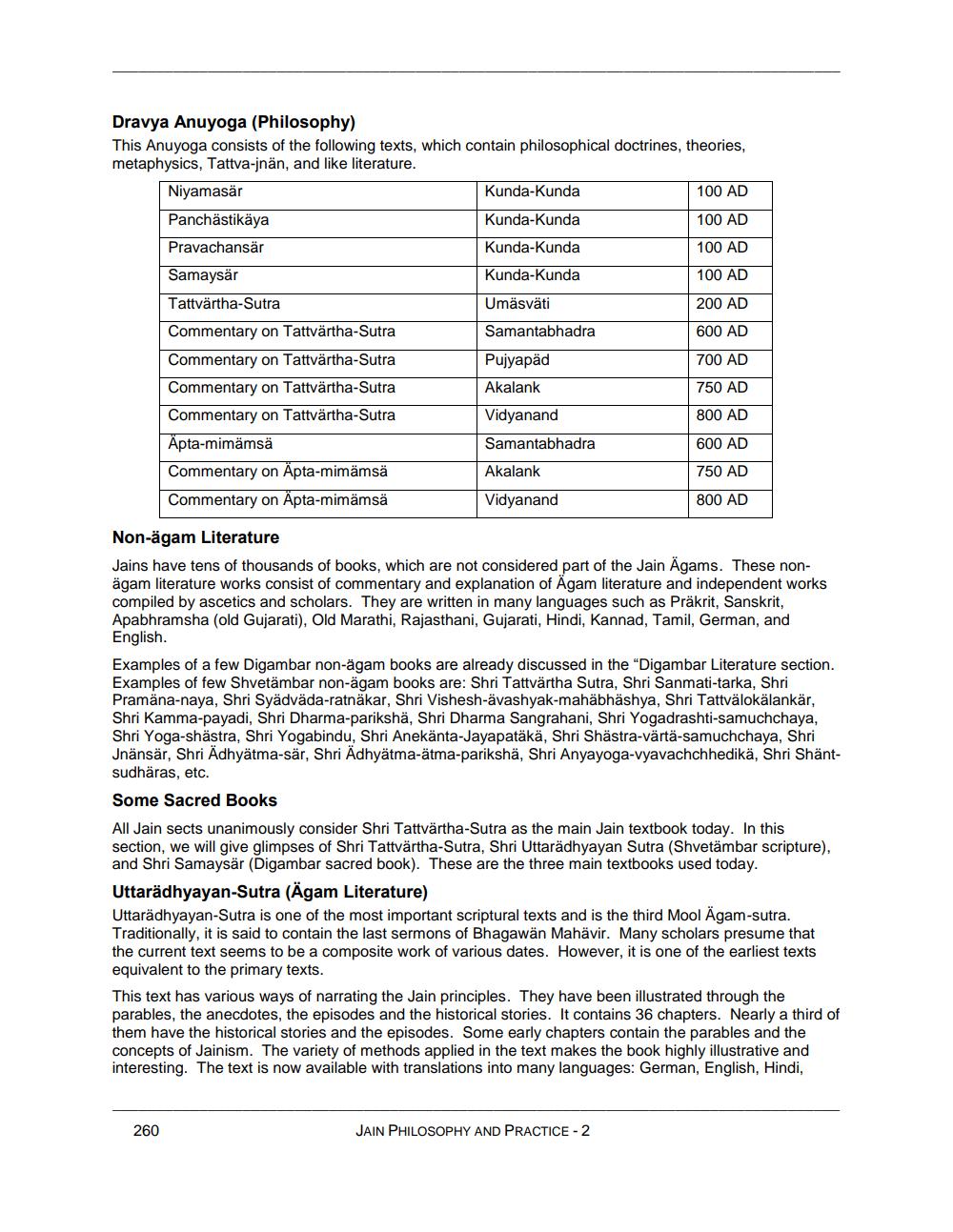________________
Dravya Anuyoga (Philosophy) This Anuyoga consists of the following texts, which contain philosophical doctrines, theories, metaphysics, Tattva-jnän, and like literature. Niyamasär
Kunda-Kunda
100 AD Panchästikäya
Kunda-Kunda
100 AD Pravachansär
Kunda-Kunda
100 AD Samaysär
Kunda-Kunda
100 AD Tattvärtha-Sutra
Umäsväti
200 AD Commentary on Tattvärtha-Sutra
Samantabhadra
600 AD Commentary on Tattvärtha-Sutra
Pujyapäd
700 AD Commentary on Tattvärtha-Sutra
Akalank
750 AD Commentary on Tattvärtha-Sutra
Vidyanand
800 AD Äpta-mimämsä
Samantabhadra
600 AD Commentary on Apta-mimämsä
Akalank
750 AD Commentary on Apta-mimämsä
Vidyanand
800 AD
Non-ägam Literature Jains have tens of thousands of books, which are not considered part of the Jain Agams. These nonägam literature works consist of commentary and explanation of Ägam literature and independent works compiled by ascetics and scholars. They are written in many languages such as Präkrit, Sanskrit, Apabhramsha (old Gujarati), Old Marathi, Rajasthani, Gujarati, Hindi, Kannad, Tamil, German, and English. Examples of a few Digambar non-agam books are already discussed in the “Digambar Literature section. Examples of few Shvetämbar non-agam books are: Shri Tattvärtha Sutra, Shri Sanmati-tarka, Shri Pramäna-naya, Shri Syädväda-ratnäkar, Shri Vishesh-ävashyak-mahäbhäshya, Shri Tattvälokälankär, Shri Kamma-payadi, Shri Dharma-parikshä, Shri Dharma Sangrahani, Shri Yogadrashti-samuchchaya, Shri Yoga-shästra, Shri Yogabindu, Shri Anekanta-Jayapatäkä, Shri Shastra-värtä-samuchchaya, Shri Jnänsär, Shri Adhyatma-sär, Shri Adhyatma-ätma-parikshä, Shri Anyayoga-vyavachchhedikä, Shri Shäntsudhäras, etc. Some Sacred Books All Jain sects unanimously consider Shri Tattvärtha-Sutra as the main Jain textbook today. In this section, we will give glimpses of Shri Tattvärtha-Sutra, Shri Uttaradhyayan Sutra (Shvetämbar scripture), and Shri Samaysär (Digambar sacred book). These are the three main textbooks used today. Uttaradhyayan-Sutra (Ägam Literature) Uttaradhyayan-Sutra is one of the most important scriptural texts and is the third Mool Ägam-sutra. Traditionally, it is said to contain the last sermons of Bhagawan Mahävir. Many scholars presume that the current text seems to be a composite work of various dates. However, it is one of the earliest texts equivalent to the primary texts. This text has various ways of narrating the Jain principles. They have been illustrated through the parables, the anecdotes, the episodes and the historical stories. It contains 36 chapters. Nearly a third of them have the historical stories and the episodes. Some early chapters contain the parables and the concepts of Jainism. The variety of methods applied in the text makes the book highly illustrative and interesting. The text is now available with translations into many languages: German, English, Hindi,
260
JAIN PHILOSOPHY AND PRACTICE - 2




